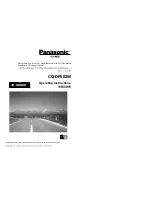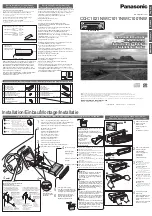
11
EN
WARNING:
Always wear ear protection where the sound level exceeds 85dB(A) and limit the
time of exposure if necessary. If sound levels are uncomfortable, even with ear protection, stop
using the tool immediately and check the ear protection is correctly fitted and provides the
correct level of sound attenuation for the level of sound produced by your tool.
WARNING:
User exposure to tool vibration can result in loss of sense of touch, numbness,
tingling and reduced ability to grip. Long-term exposure can lead to a chronic condition. If
necessary, limit the length of time exposed to vibration and use anti-vibration gloves. Do not
operate the tool with hands below a normal comfortable temperature, as vibration will have a
greater effect. Use the figures provided in the specification relating to vibration to calculate the
duration and frequency of operating the tool.
Sound and vibration levels in the specification are determined according to international
standards. The figures represent normal use for the tool in normal working conditions. A poorly
maintained, incorrectly assembled, or misused tool, may produce increased levels of noise
and vibration. www.osha.europa.eu provides information on sound and vibration levels in the
workplace that may be useful to domestic users who use tools for long periods of time.
Carefully read and understand this manual and any label attached to the tool before use.
Keep these instructions with the product for future reference. Ensure all persons who use this
product are fully acquainted with this manual.
Even when used as prescribed it is not possible to eliminate all residual risk factors. Use with
caution. If you are at all unsure of the correct and safe manner in which to use this tool, do
not attempt to use it.
General Power Tool Safety Warnings
WARNING!
When using electric power tools, basic safety precautions should always be
followed to reduce the risk of fire, electric shock and personal injury including the following
safety information. Read all these instructions before attempting to operate this product and
save these instructions for future use.
WARNING:
This appliance is not intended for use by persons (including children) with reduced,
physical or mental capabilities or lack of experience or knowledge unless they have been given
supervision or instruction concerning use of the appliance by a person responsible for their
safety. Children must be supervised to ensure that they do not play with the appliance.
CAUTION:
Use the power tool, accessories and tool bits etc. in accordance with these
instructions, taking into account the working conditions and the work to be performed. Use
of the power tool for operations different from those intended could result in a hazardous
situation.
The term “power tool” in the warnings refers to your mains-operated (corded) power tool or
battery-operated (cordless) power tool.
1 -
Keep work area clear
- Cluttered areas and benches invite injuries
2 -
Consider work area environment
- Do not expose tools to rain
- Do not use tools in damp or wet locations
- Keep work area well lit
- Do not use tools in the presence of flammable liquids or gases
3 -
Guard against electric shock
- Avoid body contact with earthed or grounded surfaces
(e.g. pipes, radiators, ranges, refrigerators)
4 -
Keep other persons away
- Do not let persons, especially children, not involved in the
work touch the tool or the extension cord and keep them away from the work area
5 -
Store idle tools
- When not in use, tools should be stored in a dry locked-up place, out of
reach of children
6 -
Do not force the tool
- It will perform the job better and safer at the rate for which it was
intended
7 -
Use the right tool
- Do not force small tools to do the job of a heavy duty tool
Do not use tools for purposes for which they are not intended; for example do not use
circular saws to cut tree limbs or logs
8 -
Dress appropriately
- Do not wear loose clothing or jewellery, which can be caught in moving parts
- Suitable safety footwear is recommended when working outdoors.
- Wear protective covering to contain long hair
9 -
Use protective equipment
-Use safety glasses
-Use face or dust mask if working operations create dust
WARNING:
Not using protective equipment or appropriate clothing can cause personal injury or
increase the severity of an injury.
10 -
Connect dust extraction equipment
- If the tool is provided for the connection of dust
extraction and collecting equipment, ensure these are connected and properly used
11 -
Do not abuse the power cable
- Never pull the power cable to disconnect it from the
socket. Keep the power cable away from heat, oil and sharp edges. Damaged or entangled
power cables increase the risk of electric shock
12 -
Secure work
- Where possible use clamps or a vice to hold the work. It is safer than
using your hands
13 -
Do not overreach
- Keep proper footing and balance at all times
14 -
Maintain tools with care
- Keeping cutting tools sharp and clean makes the tool easier to control and less likely to
bind or lock in the workpiece
- Follow instructions for lubricating and changing accessories
- Inspect tool power cables periodically and have them repaired by an authorised service
facility if damaged
- Inspect extension cables periodically and replace if damaged
- Keep handles dry, clean and free from oil and grease
WARNING:
Many accidents are caused by poorly maintained power tools.
15 -
Disconnect tools
- Disconnect tools from the power supply when not in use, before
servicing and when changing accessories such as blades, bits and cutters
WARNING:
The use of accessories or attachments not recommended by the manufacturer may
result in a risk of injury to persons.
16 -
Remove adjusting keys and wrenches
- Form the habit of checking to see that keys
and adjusting wrenches are removed from the tool before switching it on
17 -
Avoid unintentional starting
- Ensure switch is in “off” position when connecting to a
mains socket, inserting a battery pack, or when picking up or carrying the tool
WARNING:
Unintended starting of a tool can cause major injuries.
18 -
Use outdoor extension leads
- When the tool is used outdoors, use only extension cords
intended for outdoor use and so marked. Use of an extension cable suitable for outdoor
use reduces the risk of electric shock
19 -
Stay alert
- Watch what you are doing, use common sense and do not operate the tool when you are
tired
- Do not use a power tool while you are under the influence of drugs, alcohol or
medication
WARNING:
A moment of inattention while operating power tools may result in serious personal
injury.
20 -
Check damaged parts
- Before further use of tool, it should be carefully checked to determine that it will operate
properly and perform its intended function
- Check for alignment of moving parts, binding of moving parts, breakage of parts,
mounting and any other conditions that may affect its operation
- A guard or other part that is damaged should be properly repaired or replaced by an
authorised service centre unless otherwise indicated in this instruction manual
- Have defective switches replaced by an authorised service centre
WARNING:
Do not use the tool if the on/off switch does not switch the tool on and off. The
switch must be repaired before the tool is used.
21 -
Have your tool repaired by a qualified person
- This electric tool complies with the
relevant safety rules. Repairs should only be carried out by qualified persons, otherwise
this may result in considerable danger to the user
WARNING:
When servicing use only identical replacement parts.
WARNING:
If the power cable is damaged it must be replaced by the manufacturer or an
authorised service centre.
22 -
Power tool mains plugs must match the mains socket
- Never modify the plug in any
way. Do not use any adapter plugs with earthed (grounded) power tools. Unmodified plugs
and matching sockets will reduce risk of electric shock
23 -
If operating a power tool outside use a residual current device (RCD)
- Use of an RCD
reduces the risk of electric shock
NOTE:
The term “residual current device (RCD)” may be replaced by the term “ground fault
circuit interrupter (GFCI)” or “earth leakage circuit breaker (ELCB)”.
WARNING:
When used in Australia or New Zealand, it is recommended that this tool is ALWAYS
supplied via Residual Current Device (RCD) with a rated residual current of 30mA or less.
WARNING:
Before connecting a tool to a power source (mains switch power point receptacle,
outlet, etc.) be sure that the voltage supply is the same as that specified on the nameplate of
the tool. A power source with a voltage greater than that specified for the tool can result in
serious injury to the user, and damage to the tool. If in doubt, do not plug in the tool. Using a
power source with a voltage less than the nameplate rating is harmful to the motor.
Cutting tool safety
WARNING.
Before connecting a tool to a power source (mains switch power point receptacle,
outlet, etc.) be sure that the voltage supply is the same as that specified on the nameplate of
the tool. A power source with a voltage greater than that specified for the tool can result in
serious injury to the user, and damage to the tool. If in doubt, do not plug in the tool. Using a
power source with a voltage less than the nameplate rating is harmful to the motor.
Use the correct cutting tool
• Ensure the cutting tool is suitable for the job. Do not assume a tool is suitable without
checking the product literature before use
Protect your eyes
• Always wear appropriate eye protection when using cutting tools
• Spectacles are not designed to offer any protection when using this product; normal
lenses are not impact resistant and could shatter
350767/850827_Manual.indd 11
13/02/2020 10:09
Summary of Contents for TSPL 152
Page 2: ...2 1 2 3 7 8 6 5 8 4 12 8 13 11 10 9 8 350767 850827_Manual indd 2 13 02 2020 10 09 ...
Page 4: ...4 48 47 46 45 37 38 39 40 41 44 43 42 2 350767 850827_Manual indd 4 13 02 2020 10 09 ...
Page 5: ...5 Image A Image B Image C Image D 350767 850827_Manual indd 5 13 02 2020 10 09 ...
Page 9: ...9 350767 850827_Manual indd 9 13 02 2020 10 09 ...
Page 25: ...25 EN 25 NL 350767 850827_Manual indd 25 13 02 2020 10 09 ...
Page 35: ...35 EN 35 FR 350767 850827_Manual indd 35 13 02 2020 10 09 ...
Page 87: ...87 EN E PT E 87 RU 350767 850827_Manual indd 87 13 02 2020 10 09 ...
Page 120: ...350767 850827_Manual indd 120 13 02 2020 10 10 ...












































